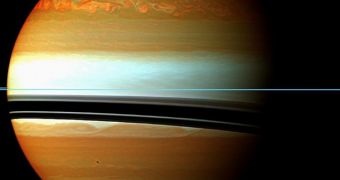For nearly an entire Earth year, a massive storm devastated the atmosphere above Saturn, baffling experts with its unusual intensity. Data collected by the NASA Cassini orbiter as the storm took place have now been centralized in a series of images and animations of what went on.
Researchers hope to use these data to better understand the dynamics of the Saturnine atmosphere. The space probe has been analyzing the gas giant, its ring system and its moons since July 1, 2004.
As such, Cassini was there when the massive storm began. It watched the event as it unfolded, grew in spread and intensity, and then decimated the atmosphere. The probe also saw it decay and disappear, in the northern hemisphere of the planet.
The early seeds became noticeable in data sent back to Earth on December 5, 2010. About two months later, in late January 2011, the storm had grown so much that it completely encircled the entire planet. Cassini caught the entire event in full-color images, from which experts constructed mosaics.
“The Saturn storm is more like a volcano than a terrestrial weather system. The pressure builds up for many years before the storm erupts. The mystery is that there's no rock to resist the pressure – to delay the eruption for so many years,” expert Andrew Ingersoll says.
The investigator holds an appointment as a Cassini imaging team member at the California Institute of Technology, in Pasadena. Caltech manages the NASA Jet Propulsion Laboratory (JPL), also in Pasadena, which in turn handles the Cassini spacecraft.
According to the weather records scientists keep of Saturn, the event was the largest ever to occur on the gas giant over the past two decades. It had a north-south width of nearly 9,000 miles (15,000 kilometers), and swept the planet at great speed.
Using radio and plasma wave instruments aboard Cassini, the JPL team was able to determine that the atmospheric event was a convective storm, whose active convecting phase ended in late June, 2011.
However, that was not the end of the event. Even now, 6 months later, turbulent clouds are still apparent throughout Saturn's northern hemisphere. What is interesting is that the previous record holder in terms of great storms lasted only 55 days.
“Cassini has taken hundreds of images of this storm as part of the imaging team's 'Saturn Storm Watch' campaign. During this effort, Cassini takes quick looks at the storm in between other scheduled observations of either Saturn or its rings and moons,” the JPL team says in a statement.
“The new images, together with other high-quality images collected by Cassini since 2004, allow scientists to trace back the subtle changes on the planet that preceded the storm's formation and have revealed insights into the storm's development, its wind speeds and the altitudes at which its changes occur,” the document concludes.
More pictures of the weather event can be seen here, here and here.

 14 DAY TRIAL //
14 DAY TRIAL //